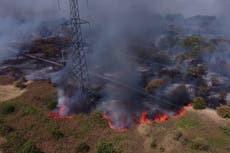US had third-hottest July on record
Texas saw its hottest July ever, as repeated heatwaves blanketed the country
This July was the third-hottest on record in the US, in what is shaping up to be another hot year for the country.
Heatwaves that swept across the country, from the northeast to the central Plains and the Pacific Northwest, contributed to the extreme heat this past month.
Texas, which saw some of the worst and most prolonged heatwaves, had its hottest July ever, according to the new analysis from the US National Oceanic and Atmospheric Administration (NOAA).
The intense heat is just another reminder of how much and how quickly the climate crisis is warming the planet.
Most of the country saw above-average temperatures, including most of the west, the south and the northeast. Temperatures in the upper Midwest were around average or slightly below average, NOAA reports.
In addition to the record warmth in Texas, California and Florida saw their sixth-warmest July on record, the agency adds.
Heat routinely reached above 100 degrees Fahrenheit (38 degrees Celsius) in much of Texas last month as the heatwaves piled on. That intense heat, coupled with ongoing extreme drought across the state, led to multiple wildfire outbreaks.
So far, this year is in the warmest 20 per cent of all January - July periods on record for the US, NOAA says.
But July was exceptional for more than just the heat — many areas also saw extreme rain or drought.
Some corners of Texas saw their driest month ever, while other parts of California tied their record driest month — with no rain whatsoever.
Over 51 per cent of the lower 48 states, mainly out west, is experiencing drought conditions, according to the US government’s drought monitor. In some states, like Texas, California and Nevada, vast areas of land are seeing “exceptional drought”, the highest ranking of drought conditions.
Western North America is currently in the midst of a decades-long “megadrought” fuelled by the climate crisis, making it the driest period for at least 1200 years.
But most of eastern Kentucky saw its wettest month ever, a reminder of how the climate crisis can fuel both dry and wet extremes.
Intense storms near the end of July led to rapid and catastrophic flooding in eastern Kentucky, with at least 37 people dead. Overall, July was the fourth-wettest July on record in Kentucky.
In addition, some areas in and around St Louis, Missouri broke single-day rainfall records on July 26. Those rains created flash floods, shut down many roads and left one person dead.
Globally, the hottest month ever recorded was July 2021, according to NOAA data from last year. A global analysis of last month’s temperature isn’t yet available.
The climate crisis is expected to lead to more extreme weather like heatwaves, storms and droughts as greenhouse gases, mainly derived from producing and burning fossil fuels, continue to fill the atmosphere and warm the planet.
So far, the world has warmed 1.2C above 19th-century temperatures — and is on track to reach 2.7C of warming by the end of the century, according to the Climate Action Tracker, an independent analysis of global climate policy.
As the world reaches 2C of warming and beyond, things like heatwaves and droughts can be expected to grow more frequent and intense, according to a UN climate science panel.
Join our commenting forum
Join thought-provoking conversations, follow other Independent readers and see their replies
Comments


Bookmark popover
Removed from bookmarks